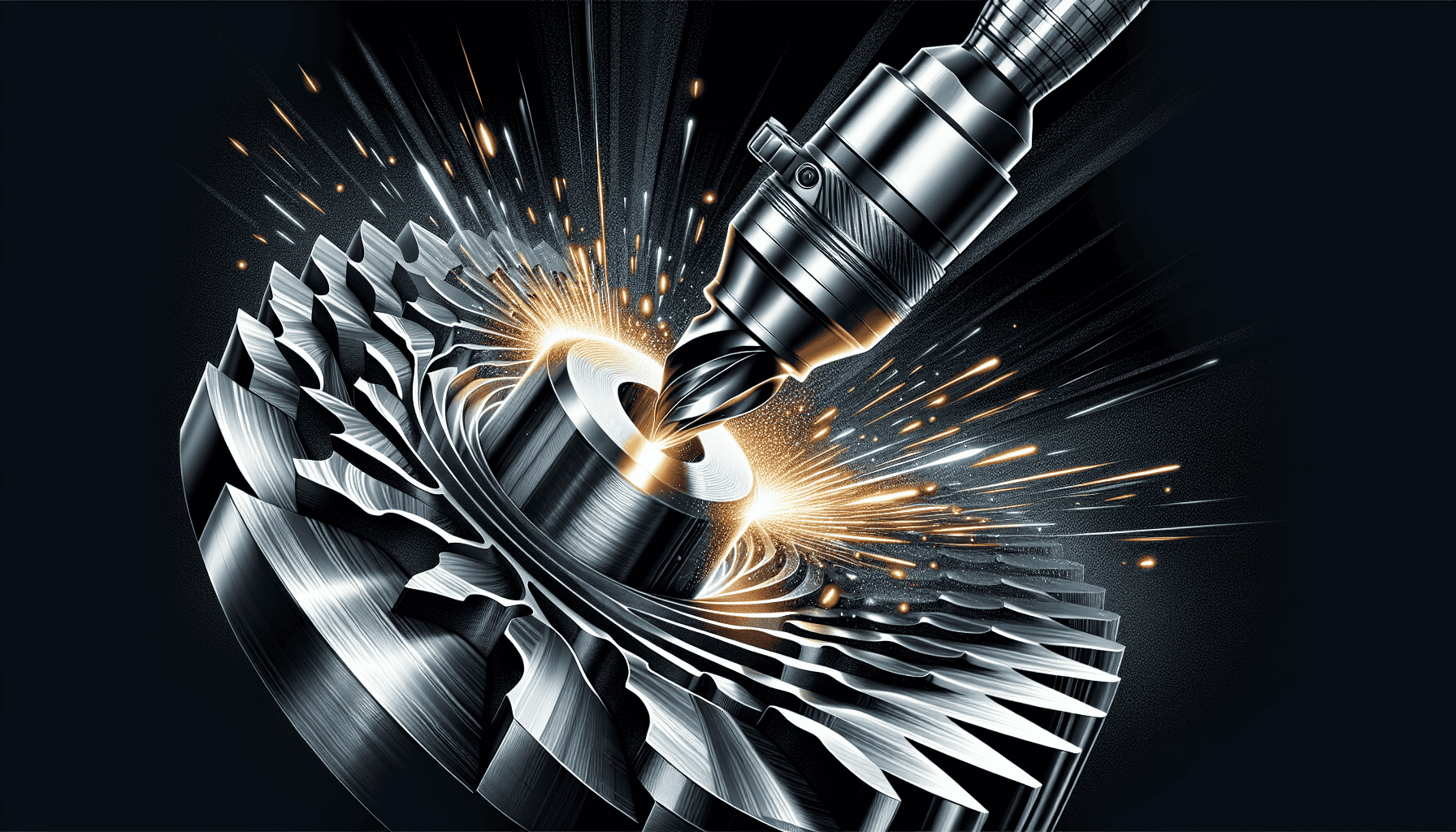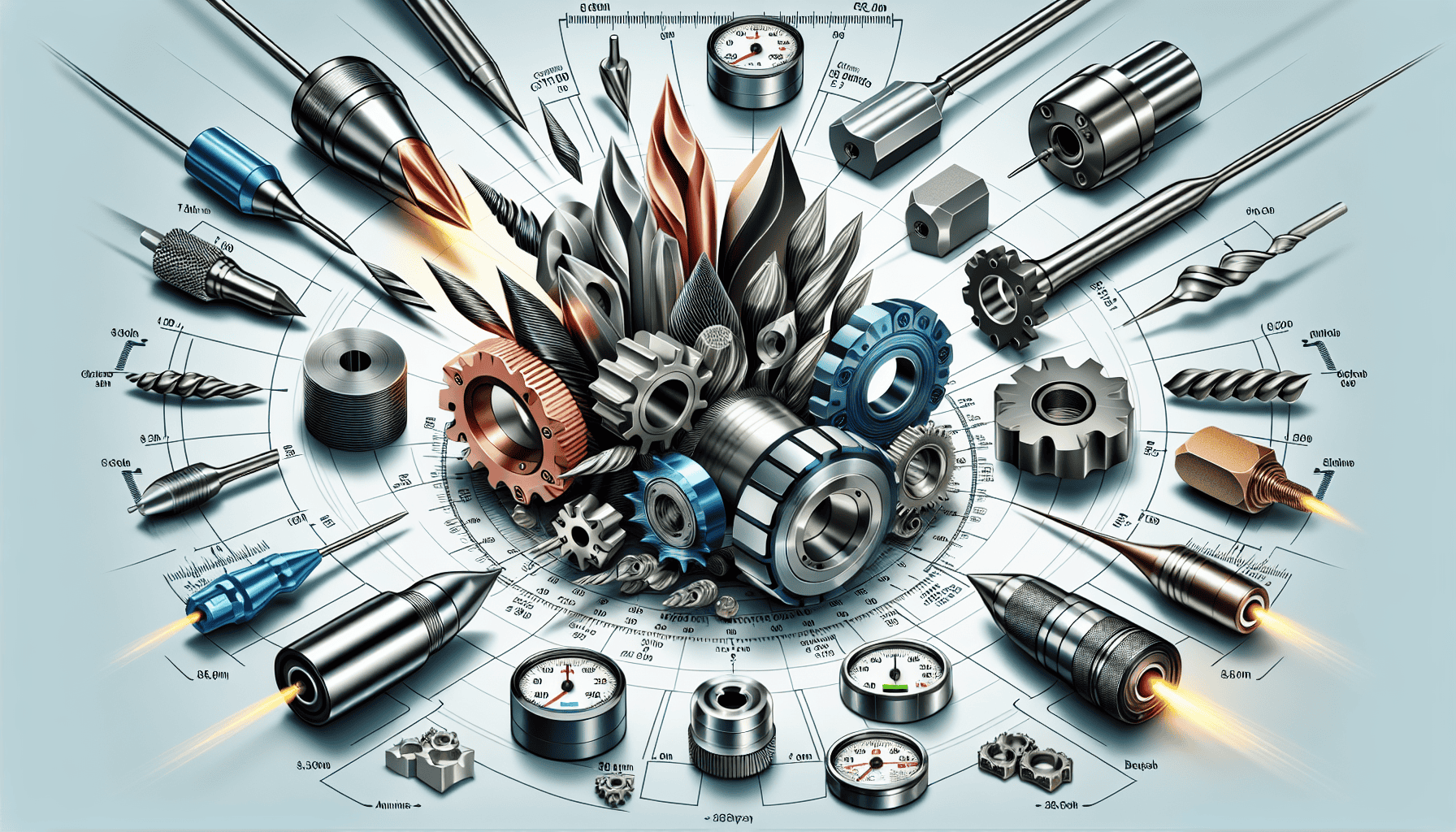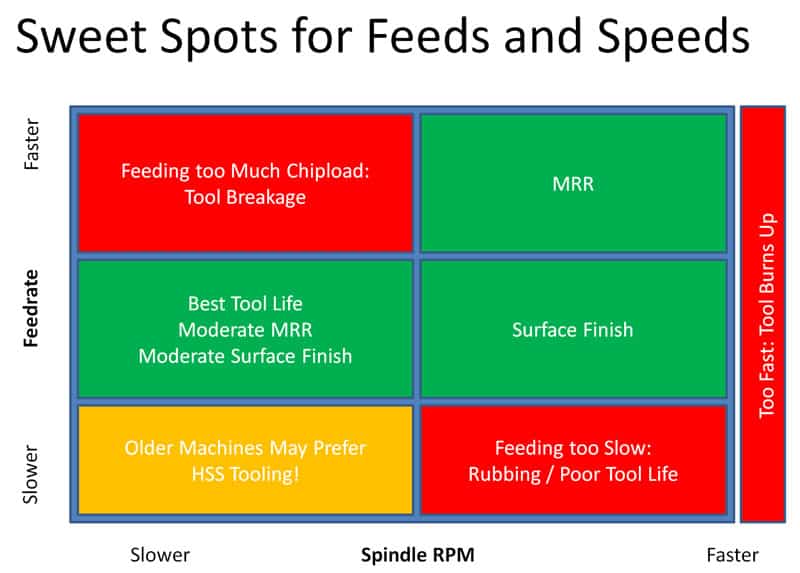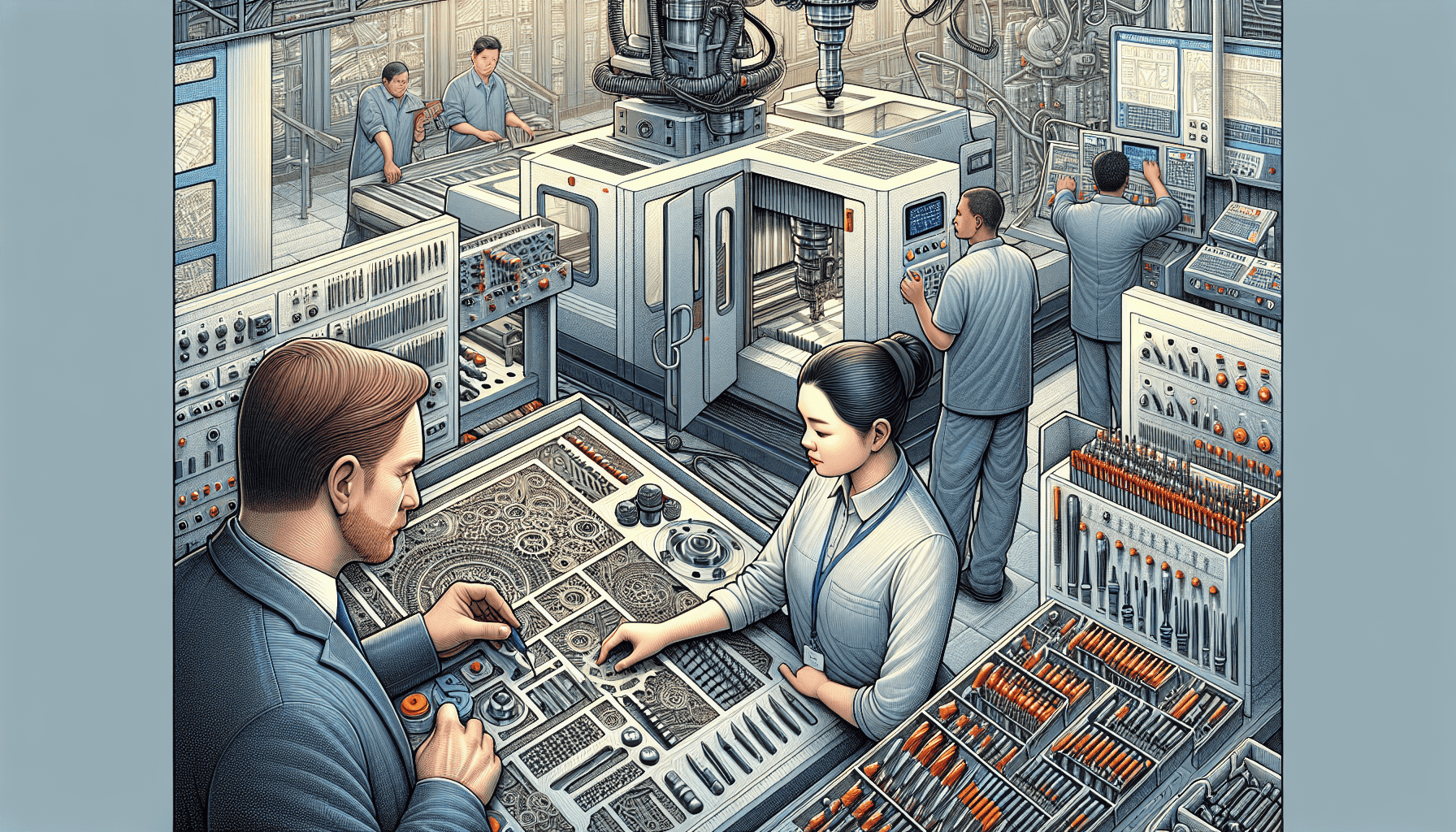When it comes to CNC machining, knowing the difference between feed rate and cutting speed can make or break your operation’s efficiency and precision. Understanding the concept of “feed rate vs cutting speed” is crucial.
Feed rate is about the tool’s progression through the workpiece, directly affecting chip thickness and machining time. Cutting speed—the tool edge’s velocity—primarily influences tool wear and energy expenditure.
This article unfolds the intricacies of feed rate vs cutting speed, delivering practical insights on harnessing their interplay to elevate the performance and quality of your CNC applications.
Key Takeaways
- Feed rate and cutting speed are critical parameters in CNC machining, with feed rate determining the pacing of the cutting tool through the workpiece and cutting speed dictating the velocity of the cutting edge, both impacting outcomes such as productivity, tool life, and surface finish.
- Optimal cutting speeds require careful consideration of tool and workpiece materials; harder materials necessitate slower speeds to reduce tool wear, while softer materials allow for faster speeds and improved efficiency.
- Balancing spindle speed, feed rate, and cutting speed is essential for successful CNC operations, as each factor contributes to the nature of chip formation, machining efficiency, tool life, and the overall performance of the machining process.
- The Best Tool for finding your ideal spindle speed, feed rate, and cutting speed is a Feeds and Speeds Calculator, such as our G-Wizard Calculator.
Exploring the Dynamics of Feed Rate and Cutting Speed

In the throbbing heart of a CNC machine, feed rate and cutting speed are the pulse that drives the operation. They are distinct parameters that govern how the cutting tool interacts with the workpiece, significantly influencing productivity, tool life, and surface finish. When it comes to enhancing your machining operations, understanding the interplay between these two factors is crucial.
When the cutting tool dances through the workpiece, it performs a delicate balancing act. On one side, the cutting speed, or the cutting edge’s velocity, affects tool life and power usage. On the other, the feed rate, which refers to the tool’s advancement through the workpiece, determines machining time and surface roughness. Now, let’s delve deeper into these concepts to understand their individual roles in the machining process.
Defining Feed Rate
Feed rate, in the simplest terms, is the speed at which the cutting tool advances through the workpiece in a specific direction. It’s like the pace at which a dancer moves across the stage - too slow, and the performance drags; too fast, and the dancer might stumble. In CNC machining, getting the feed rate right is crucial for achieving optimal results.
Measured in terms of the distance the cutting tool travels per minute or per revolution, feed rate dictates how fast the cutter moves against the workpiece. Consequently, it directly controls tool engagement and the thickness of the chip being removed. And it’s not just about speed; feed rate also plays a crucial role in determining the optimal chip load, which factors into the cutter’s RPM.
From productivity to surface roughness, feed rate pulls quite a few strings in the CNC machining process.
Understanding Cutting Speed
While feed rate controls the cutter’s dance, cutting speed sets the rhythm. Cutting speed is the relative velocity between the cutting tool and the workpiece’s surface. It’s like the beat of music that guides a dancer’s steps - too slow, and the dance lacks energy; too fast, and the dancer can’t keep up. In CNC machining, the right cutting speed is key to efficiency and quality.
Measured in meters per minute or feet per minute, cutting speed determines the rate at which the cutting tool engages with the material. By influencing the machining process’s efficiency and quality, it plays a vital role in outcomes ranging from tool life to power usage. Whether you’re striving for higher productivity or better surface finish, understanding and optimizing cutting speed is a must.
Achieving Optimal Cutting Speeds

So, we’ve established that cutting speed is important. But how do you achieve the optimal cutting speed? It’s not as simple as cranking up the dial. Several factors come into play, including:
- Tool material
- Workpiece material
- Tool cost
- Quantity of parts produced
Getting this balance right is critical for maximizing the productivity and efficiency of your CNC machining operations.
On the one hand, tool material impacts allowable cutting speeds. High-strength materials like carbide permit higher speeds but provide lower tool life, whereas softer materials experience faster wear at higher speeds. On the other hand, workpiece materials like aluminum can withstand higher cutting speeds due to lower resistance and minimized tool wear, compared to harder materials such as low carbon steel.
Let’s delve deeper into these considerations.
Material Considerations
There’s no one-size-fits-all cutting speed for all materials. The hardness of the workpiece material plays a significant role in determining the appropriate cutting speed for CNC machining operations. It’s like choosing the right gear for a bicycle ride - uphill requires a different gear than downhill. In CNC machining, harder materials require slower cutting speeds to prevent excessive tool wear and maintain the integrity of the cutting process.
On the other hand, softer workpiece materials can accommodate higher cutting speeds, which enables a more efficient machining process without an undue risk of tool wear. This highlights the importance of choosing the right cutting speed based on the hardness of the workpiece material. But it’s not just the workpiece material that matters; the cutting tool material also plays a significant role.
Tool Material Selection
When it comes to cutting tools, not all are created equal. The recommended cutting speeds are influenced by the type of cutting tool, its material composition, and its geometry. These factors play a significant role in determining the optimal speed for cutting operations, whether it’s a higher cutting speed or a lower cutting speed. Think of it like a painter choosing the right brush for a painting - a watercolor brush won’t work well with oil paint. Similarly, in CNC machining, carbide tools allow for higher cutting speeds than tools made of high-speed steel.
Choosing the right tool for the material and cutting operation is critical to prevent tool breakage. It’s a delicate balancing act - using a tool that’s too hard can increase the risk of breakage, while using one that’s too soft can lead to faster wear. It’s all about finding the sweet spot for optimal cutting speeds.
The Art of Determining Optimal Feed Rate
Just as with cutting speed, finding the optimal feed rate is a delicate balancing act. It involves considering:
- Chip load per tooth
- Machine power
- Cutter sharpness
- The material being cut
These factors are instrumental in achieving the desired part quality and surface finish. But how do you strike the right balance?
Well, it’s all about control. By adjusting the feed rate, you can control the chip formation process, directly affecting the quality of the surface and tolerances due to variations in chip size and evacuation. Improper feed rates can cause tool breakage or excessive premature wear, impacting the overall cost efficiency and safety of the machining operations.
By optimizing feed rates, you can promote higher productivity while managing the acceleration and deceleration of cutters to maintain consistent chip thickness. But there’s one more factor to consider - chip load.
Balancing Chip Load and Machine Efficiency
In the world of CNC machining, chip load isn’t just a byproduct; it’s an essential factor in optimizing material removal rate and machine efficiency. Chip load determines the material removal per tooth of the cutter and influences the overall load the machine can manage. It’s like the weight a dancer can carry - too much, and they might stumble; too little, and they’re not pushing their limits.
By carefully adjusting chip load, you can balance the material removal rate with the machine’s efficiency to optimize the machining process. And it’s not just about speed; fine-tuning the chip load can minimize cycle times without compromising the machine’s efficiency. In essence, balancing chip load is a key component in getting the most out of your CNC machine.
Interplay Between Spindle Speed, Feed Rate, and Cutting Speed

In the grand ballet of CNC machining, spindle speed, feed rate, and cutting speed all dance together in harmony. Spindle speed, measured in revolutions per minute (RPM), directly influences the surface speed of the tool or workpiece and is calculated based on the desired surface speed and the tool or workpiece diameter. It’s the conductor guiding the orchestra, dictating the rate of material removal from the workpiece and affecting both the feed rate and cutting speed.
But it’s not just about dictating the pace. The spindle speed and feed rate combine to determine the cut’s aggressiveness and the nature of chip formation, which are crucial for machining efficiency and tool life.
In other words, the interplay between spindle speed, feed rate, and cutting speed is the key to pulling off a successful performance in the CNC machining process.
Properly balancing your feed rate and cutting speed leads to what I like to call a "Sweet Spot" when machining. The above chart shows the interplay of these factors. Green sections are sweet spots for various properties including:
- MRR: Maximize Material Removal Rate to create the shortest cycle times.
- Tool Life: A little slower Cutting Speed will kick up your Tool Life.
- Surface Finish: A little faster Cutting Speed coupled with a bit slower Feed Rate will give the best surface finish.
The Best Tool for helping you to select your ideal balance of Feed Rate and Cutting Speed is a Feeds and Speeds Calculator, like our G-Wizard Calculator.
Spindle Speed and Its Effect on Operations
The influence of spindle speed on CNC machining operations is not to be underestimated. Here are some key points to consider:
- Larger cutter diameters can handle larger chip loads, which directly affects the achievable feed rate when the spindle speed is increased.
- It’s like the speed of a car - the faster it goes, the more fuel it consumes.
- In CNC machining, tool life is directly influenced by cutting speed, feed rate, and depth of cut, all of which need to be optimized to enhance production and reduce tool wear.
However, pushing the spindle speed too high can lead to tool wear and breakages, while incorrect spindle speed can result in overheating and poor cutting conditions. That’s why it’s crucial to find the sweet spot where tool strength and CNC machine capabilities dictate how spindle speed will affect the overall cutting process. It’s all about striking a balance - too fast or too slow, and you risk damaging your tool and compromising the machining process.
Strategies to Prevent Tool Wear and Breakage

Preventing tool wear and breakage is a top priority in the world of CNC machining. It involves striking the right balance between cutting speed and feed rate, selecting the proper tool, and conducting regular maintenance. Think of it as maintaining a race car - you need to fine-tune the engine, choose the right tires, and perform regular check-ups to ensure optimal performance.
Cutting tools can have a longer service life when operated within the recommended cutting speed range. This helps minimize wear and reduces the risk of tool breakage. But it’s not just about speed. Feed rate impacts the amount of material removed and the heat produced during cutting, which can subsequently affect tool life. Moreover, improper feed rates can result in issues such as:
- chatter
- vibration
- work hardening
- poor surface finishes
- cutter failure
Therefore, regular maintenance, proper machine tool selection, and vigilant monitoring of machining conditions are essential for mitigating tool breakage.
Navigating the CNC Machining Process: Practical Tips
Navigating the CNC machining process can be a complex task, but with the right tips and tricks, it can become a lot easier. Here are some tips to help you:
- Gain experience on manual machines to build a foundational knowledge of various materials and their cutting characteristics, which is valuable when programming CNC machines.
- Start with simple projects and gradually work your way up to more complex ones.
- Take advantage of online resources and tutorials to learn more about CNC machining.
- Stay organized and keep track of your tooling and materials to ensure efficient workflow.
- Don’t be afraid to ask for help or seek advice from experienced machinists. By following these tips, you can improve your CNC machining skills and tackle more challenging projects with confidence.
Another useful tip is occasionally pushing the boundaries of tooling feeds and speeds, even at the risk of tool breakage. This helps understand the limitations and capabilities of the tools used in CNC machining. It’s all about exploring and experimenting - only by pushing the limits can you truly discover what your tools and machines are capable of.
Summary
As we’ve seen, the world of CNC machining is a complex interplay of feed rate, cutting speed, and spindle speed. These parameters are the backbone of any CNC operation, driving everything from productivity and tool life to the surface finish of the final product. Understanding and optimizing these parameters is key to achieving the best results, whether you’re aiming for higher productivity, better surface finish, or extended tool life.
But remember, there’s no one-size-fits-all solution. Achieving optimal results involves a delicate balancing act that takes into account factors such as tool material, workpiece material, machine capabilities, chip load, and more. It’s a continuous process of fine-tuning and adjustment, requiring a keen eye for detail and a deep understanding of the machining process. So, keep experimenting, keep learning, and keep pushing the boundaries of what’s possible in the world of CNC machining.
Frequently Asked Questions
What is feed rate in CNC machining?
Feed Rate in CNC Machining is the speed at which the cutting tool moves through the workpiece in a particular direction. It is measured in either distance per minute or per revolution.
How does cutting speed affect the CNC machining process?
Cutting speed greatly influences the efficiency and quality of the CNC machining process by determining the rate at which the cutting tool engages with the material.
How can I achieve optimal cutting speeds?
To achieve optimal cutting speeds, consider factors such as tool material, workpiece material, tool cost, and the quantity of parts produced. The hardness of the workpiece and the material and geometry of the cutting tool also play a significant role.
Why is balancing chip load important in CNC machining?
Balancing chip load is crucial in CNC machining because it impacts material removal per tooth and overall machine load capacity, thus optimizing material removal rate and efficiency.
What strategies can help prevent tool wear and breakage?
To prevent tool wear and breakage, it is important to balance cutting speed and feed rate, select the right tool, and perform regular maintenance. Following the recommended cutting speed range and adjusting the feed rate can also be beneficial.
Be the first to know about updates at CNC Cookbook
Join our newsletter to get updates on what's next at CNC Cookbook.